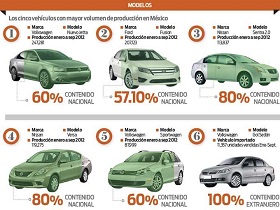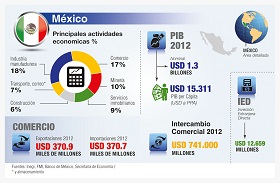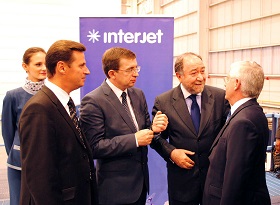In recent years Mexico has become Russia’s key economic partner in Latin America, although despite noticeable growth, there is significant untapped potential in terms of economic cooperation between the two countries. The issue on the agenda is improving the business cooperation model in order to enhance the dynamics and stability of reciprocal flows of goods and services.
Mexico’s Economy: Overview
The main thing to bear in mind, when looking at the potential dividends from Russia’s economic cooperation with Mexico, is the country’s changing economic image. Alongside Brazil and Argentina, Mexico is one of Latin America’s leading industrialized nations. Mexico boasts the second largest GDP of any country in Latin America (USD 1.2 trillion in 2012) after Brazil, and globally is ranked 16th for foreign trade and 14th place for capital outflow [1].
In addition, Mexico is distinguished by its comparatively high export potential and growing solvency. Most of its exports come from manufacturing (81 percent in 2012), [2] with a growing share of high-tech and medium high-tech segments. The automobile industry has generated quite impressive results. Globally, Mexico is a major producer and exporter of electronics and electrical items, durable home appliances, measuring and medical diagnostic devices, and telecoms equipment.
In value terms, the export of electronics is dominated by computers, TV sets and cellphones. Mexico is the world's largest exporter of flat-screen TVs, the fourth largest for computers, and seventh largest for cellphones [3].
Export revenues and foreign investment generate sizeable foreign currency and gold reserves, which have risen from USD 120.6 billion in 2010 to USD 167 billion in late 2012 [4]. Foreign debt is strictly controlled, with servicing payments under the volume of goods and services exported down from 31 percent in 2000 to 11 percent in 2011 [5]. There is increasing efficiency in monetary regulation, with impressive successes scored in curbing inflation, Mexico’s curse for decades. In 2012, inflation was down to the single-digits at 3.6 percent [6].
Both quantitative and qualitative indicators are rising. There is significant progress in adapting to the electronic revolution i.e. Internet development, the mass use of IT, and the use of computers and telecommunications. Mexican capital is becoming increasingly international. National firms have started investing in projects not only in Latin America but also in leading industrialized countries in Western Europe and the United States. As of 2012, Mexican accumulated private FDI stood at USD 137 billion [7].
Mexico’s comparatively high (by regional standards) industrial and investment potential is definitely a basis for the expansion and diversification of commercial interaction geared at Russia’s economic needs. Mexico is working to ease its traditional economic ties with the U.S.A. and Western Europe, diversify its exports and reach out to new markets.
Frontiers and Problems of Russian-Mexican Economic Cooperation
The current decade witnesses a rise in bilateral trade and economic interaction, with turnover at USD 1.6 billion in 2012 against USD 0.7 billion in 2010 [8]. Industrial ties are also developing, with several Russian companies already present on the Mexican market. Latin America’s largest center for servicing and repair of Russian-made helicopters has opened in the city of Veracruz. The Russian company Power Machines is involved in building the La Yesca hydropower plant. In 2013, the delivery of Sukhoi Superjet 100s began under contract with Mexican firm Interjet.
Russia and Mexico are expanding their cooperation in the peaceful research and use of outer space, with contracts implemented to develop satellite technologies and launch Mexican satellites, including successful launches of communications satellites on Proton-M carrier rockets from the Baikonur space center in 2011 and 2013. A communications satellite belonging to the Mexican company MEXSAT will be put into orbit in 2014. Closer contacts on nuclear energy and related joint research projects also seem feasible.
However, despite these positive signs, the current volume and structure of bilateral trade, economic and investment cooperation is low compared to the two countries’ potential. Mexico’s share in Russia’s total trade turnover is at a meager 0.2 percent, with a similar figure for the Mexican side – 0.3 percent of total exports and 0.1 percent of imports [9]. Quantitative parameters have been growing largely thanks to rising Russian imports. In 2012, Russia’s bilateral trade deficit reached USD 601.6 million against USD 260.4 million in 2011 [10].
The structure of Russian exports is slowly changing, but commodities and low value-added goods such as chemical fertilizers, metallurgical equipment, gasoline, industrial oils and urea remain dominant. In 2012, machinery comprised just 3.1 percent of Russian exports [11]. Russia is becoming a major importer of Mexican finished goods, upgrading Mexico’s exports, which means that Moscow is losing ground. About 20 years ago, Mexico was a significant consumer of Russian machines and equipment, but now the situation has reversed. In 2012, their share in Russia’s imports from Mexico soared to 67 percent [12].
Cooperation in investment is at a critically low level, in early 2012 total Mexican investment in Russia amounted to USD 67 million, and Russian investment in Mexico was even lower at USD 39 million, which appears ridiculous given total FDI in Mexico. In 2012, this figure was USD 13.4 billion, [13] while in 2013 expected inflow should reach USD 35 billion.
Broadly, the Russia-Mexico trade and economic relationship lacks dynamics and stability due to objective and subjective reasons. Key hurdles are
- Russia’s decline in machine building and poor export diversification.
- Russia’s backwardness in technologies and innovations. - The sluggishness of Russian businesses and scarcity of companies able to compete against the TNCs in the Mexican market, chiefly against U.S. and Canadian corporations that enjoy preferences under NAFTA.
- Mexico’s continuing significant dependence on the United States in trade, technologies and direct investment, which significantly narrows the room for maneuver for Mexican businesses in the geographical diversification of foreign trade.
- Mexico’s remaining antidumping practices toward certain Russian goods, such as sheet steel.
- Incomplete legal basis, with work on an agreement on the mutual stimulation of investments proceeding very slowly.
- Mexico’s tendency to use ties with Russia for additional sales of its products with no steps taken to balance mutual deliveries.
Untapped Reserves and the Outlook for Commercial Interaction
The short- and longer-term prospects for Russian-Mexican economic relations will largely hinge on Russia’s economic development and the enhanced growth of globally competitive high-tech sectors. At the same time, breaking new ground requires both sides to make more efforts to expand the range and scale of business cooperation. This chiefly relates to complementing traditional trade with the rapid development of other forms of cooperation. Global practices show that an effective solution can be found in the dynamic construction of a system of investment and research links, and in the expansion of contact in innovation and state-of-the-art technologies.
In order to improve the structure of Russian exports by lowering the share of raw materials and augmenting machinery and equipment, it seems logical to focus on cooperation in areas in which Russian firms possess the requisite technologies and international cooperation experience, i.e. in fuel and energy, metallurgy, chemical and petrochemical industry, farming, protection of environment, and renewable energy. The outlook should brighten if Mexico adopts President Nieto’s bill terminating the state monopoly on hydrocarbons and the admission of private investors, including foreigners, to exploration and production of oil and gas. Should this happen, the state company Pemex will gain the right to contract foreign firms (including foreign entities) in hydrocarbon development, production, refining, transportation and storage.
Mexico is open to investment in infrastructure development. The 2013-2018 program envisages the construction of new sea and river ports, airports, highways and railways, and telecommunications facilities – and upgrading those that already exist – as well as the attraction of foreign investment to the construction sector.
Russian-Mexican relations in science and technology also seem promising. In Moscow on an official visit in June 2011, Mexican Foreign Minister Patricia Espinosa Cantellano signed the Program for Scientific and Technical Cooperation for 2011-2012 setting out cooperation under 18 projects. Her joint statement with Russian Foreign Minister Sergey Lavrov of June 28, 2011 “underlines the feasibility and significance of strengthening bilateral cooperation between Russia and Mexican institutions for implementation of scientific and technical projects, first of all in aeronautics and aerospace technologies, energy and satellite technologies, which should rest on intergovernmental and interagency agreements” [14].
The issue of upgrading the mechanism for government support of Russian business, including preferential taxation for the export of high-tech equipment remains pressing. Besides, the system of mutual settlements and insurance of export and import operations is still very vulnerable.
Russian banking and crediting institutions should establish practical cooperation with Mexican development banks such as the National Financial Corporation, National Bank of Public Works and National Bank for Foreign Trade, which play an important role in financing domestic infrastructure projects and Mexican businesses’ foreign trade operations. A strengthening of inter-bank ties might set in motion an entire spectrum of cooperation and become an additional channel for Russian companies to enter the Mexican infrastructure construction market, as well as helping to alleviate the problem of crediting mutual machinery deliveries.
Measures aimed at building inter-regional contacts to step up interaction between Russian regions and their Mexican partners could help. To this end, it is worth noting the initiative proposed by Chairman of the Federation Council Valentina Matvienko during her official visit to Mexico in May 2013, when she suggested establishing dual senate-level control over the development of inter-regional ties, primarily between Mexico’s western states and Russia’s Far East.
On the whole, it seems clear that, this decade, Russia and Mexico seem more interested in the expansion and deepening of their interaction in economic, scientific and technological areas, which is apparent from the increasingly frequent visits made by top officials and the active interaction of Russian and Mexican businesspeople on the sidelines. The same is true for the current preparations for the Russia-Mexico agreement on nuclear energy cooperation. There is undeniably more contact through chambers of commerce and business missions.
At the same time, the promotion of Russian business interests in the Mexican market does require more dynamic employment of the entire range of diplomatic, financial and information support. As an initial step, Russian exporters of highly innovative machinery could be granted lower customs duties and other tax concessions, as is widely practiced elsewhere in the world. Numerous benefits could result from the establishment of a joint fund for the encouragement and guarantees of mutual investment. It is important to remember the need for the continuous promotion of a positive image of Russia in Mexico, especially as anti-Russian rhetoric in Western media remains strong.
1. Gobierno de la República. Plan Nacional de desarrollo 2013-2018. México 2013, p. 93.
2. Informe anual 2012. Banco de México. México, 2013. P. 122.
3. Secretaría de economía. Industria automotriz. México 2012, p. 24.
4. CEPAL. Estudio económico de América Latina y el Caribe 2013. Santiago de Chile, 2013, p.200.
5. World Bank. International Debt Ststistics 2013. Washington, 2013, p. 202.
6. CEPAL. Estudio económico de América Latina y el Caribe 2013. Santiago de Chile, 2013, p. 212.
7. UNCTAD.World Investment Report. New York and Geneva, 2013, p.219.
8. Federal Customs Service (FTS). Customs Statistics of Russian Federation’s Foreign Trade. Moscow: 2012. Pp.11-12.
9. Calculated by FTS data: Federal Customs Service (FTS). Customs Statistics of Russian Federation’s Foreign Trade. Moscow: 2012. С.I, 12; CEPAL. Estudio económico de América Latina y el Caribe 2012. Santiago de Chile, 2013, p. 184.
10. Federal Customs Service. Customs Statistics of Russian Federation’s Foreign Trade. Moscow: 2012. P. 340
11. Ibíd.
12. Ibíd.
13. CEPAL La inversión extranjera directa en América Latina y el Caribe 2012. Santiago, 2013, p.26.
14. Joint Statement of Russian Foreign Minister Sergey Lavrov and Mexican Foreign Minister Patricia Espinosa Cantellano http://base.consultant.ru/cons/cgi/online.cgi?req=doc;base=INT;n=52207








